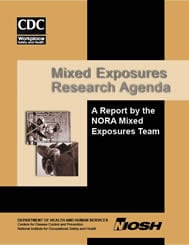Mixed Exposures Research Agenda - A Report by the NORA Mixed Exposures Team
December 2004
DHHS (NIOSH) Publication Number 2005-106

Workers are continuously exposed to a wide variety of chemical substances, biological agents, physical agents, and other stressors encountered both in and out of the workplace. Each stressor has the potential to cause a physiological effect, whether it is a prescribed pharmaceutical, consumed food, cleaning product, automotive exhaust emission, solvent, ultraviolet radiation, noise, whole-body vibration, or social or psychological stress. Mixed exposures may produce acute or chronic effects or a combination of acute and chronic effects, with or without latency. Other exposures in combination with certain stressors may produce increased or unexpected deleterious health effects, or they may combine or interact in the environment to create a new exposure risk. Exposures to mixed stressors can produce health consequences that are additive, synergistic, antagonistic, or can potentiate the response expected from individual component exposures. This is the complex problem that faces environmental scientists and public health officials in setting and carrying out public health policy for the general environment, consumer product and food and drug safety, and the protection of workers. Because the issue of mixed exposures affects all of these areas, it was selected as one of the priority areas of the National Occupational Research Agenda (NORA) to leverage collaborative research efforts for better understanding the complex interactions of mixed exposures.
The mixed exposures research agenda includes the elements generally found in public health responses: surveillance, evaluation and research, and controls and interventions. Health surveillance is needed to identify mixtures with adverse health effects that cannot be explained by the toxicity of the individual components in a mixed exposure. Exposure surveillance is needed to identify workers exposed to mixtures with observed potential effects. To create manageable priorities for research and worksite interventions, systems are needed for ranking mixed exposures on the basis of knowledge about health effects and the degree to which exposure is likely to occur.
Mixed Exposures Research Agenda – A Report by the NORA Mixed Exposures Teampdf icon [PDF – 602 KB]
